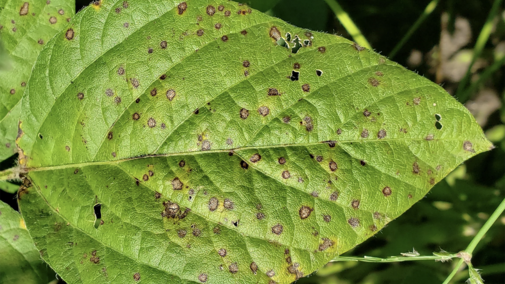In the last five years, foliar diseases of soybean account for an average of $9.4 million economic losses to soybean grown in Nebraska. Use of foliar fungicides is a common disease management strategy and has increased in the last few years due to increasing disease pressure. Continuous planting of soybean and minimum tillage can increase disease pressure caused by certain pathogens. In addition, use of single-site mode of action fungicides could be a driving factor for development of fungicide resistance leading to disease control failures.
In 2019, QoI fungicide resistance was detected in 109 of 111 Cercospora sojina samples from 10 counties in Nebraska. In an effort to understand the prevalence of fungicide resistance, this survey was expanded in 2020 and 375 samples were collected from 48 counties throughout the soybean producing region in Nebraska. These samples are currently being tested for their QoI fungicide sensitivity. Detection of fungicide resistance is key for making recommendations, and the next goal is to understand how to best communicate these results.
Researchers at the University of Nebraska-Lincoln are conducting a survey about foliar fungicide use in Nebraska soybean fields. The goal of the survey is to determine which diseases soybean producers and agribusiness professionals believe to be most important and identify factors or sources of information used to make fungicide use decisions. The survey results can be used to help researchers better understand the factors affecting decisions to apply foliar fungicides in Nebraska. Data collected through this survey will be used to better customize future Extension programming for clientele needs.
This survey has 10 questions that takes about 10 minutes to complete and includes multiple-choice and short answer questions. It is offered as both a paper- and web-based version.
If you are a soybean producer, farm manager, Extension personnel, crop consultant, agronomist or other agribusiness representative helping producers manage soybean acres, you are invited to complete the survey. Participation is voluntary. You need to respond to the survey only once. If you have recently completed this survey, we thank you for your time and input, and there’s no need to complete it again.
How to Take the Survey
To participate in the survey, navigate to go.unl.edu/soy21 through a personal computer or smartphone. The link will initially take you to a consent form. If you agree with the information provided, please click “I agree” to start the survey.
Alternately, you can access the survey by scanning the QR code below. Please complete the survey on or before Monday, May 31, 2021.

Additional Resources:
- Crop Protection Network. 2020. Estimates of corn, soybean, and wheat yield losses due to disease: an online tool. https://loss.cropprotectionnetwork.org/
- Giesler, L.J., Miller, J.J. 2017. Managing foliar diseases in soybean. NebGuide.
- Neves, D.L., Chilvers, M.I., Jackson-Ziems, T.A., Malvick, D.K., Bradley, C.A. 2020. Resistance to quinone outside inhibitor fungicides conferred by the G143A mutation in Cercospora sojina (causal agent of frogeye leaf spot) isolates from Michigan, Minnesota, and Nebraska soybean fields. Plant Health Progress, 21:230-231.
- Mane, A.G., Everhart, S.E., Jackson-Ziems, T.A. 2020. Fungicide resistance and management of frogeye leaf spot of soybean in Nebraska. CropWatch.

